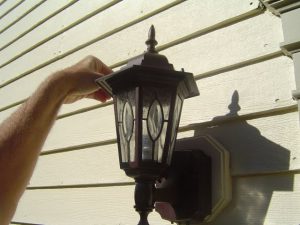Choosing Home Lighting Fixtures and Bulbs for Your Home
By Mark J. Donovan
|
|
Home lighting design is an important component of any home design plan. House lighting serves two main purposes. It provides both function and ambiance to a home and the rooms within it. Consequently you need to carefully consider lighting design for each room in your new home.
When designing a lighting plan for a room, consider the intended purpose of the room and who will be using it. Think about the activities that will be performed in the room and when they will be performed. For example, in a kitchen, most likely much of the cooking and food preparation performed in it will be done in the early morning and evening when there is little natural light. |
Consequently you want to make sure the home lighting design includes overhead general lighting as well as task lighting in every room of the home.
Also think about lighting for drawing attention. For example if a wall area is expected to have paintings or objects on it that you want people to see then make sure your home lighting design includes accent lighting.
When developing your home lighting design, make sure you ask yourself when contemplating each room, does your planned home lighting design fit both purpose and mood. A typical room lighting design will include a combination of general overhead lighting, task lighting / workspace lighting, and accent lighting. Let’s review all three types of lighting.
| General Overhead Lighting
This is the most common type of lighting people are familiar with. It is overhead lighting that either hangs from the ceiling or recessed into it. It creates the overall ambiance to the room, as it relates to lighting. General lighting can be as simple as a ceiling bulb to beautiful chandeliers. Whichever your personal taste and lighting budget, make sure to provide sufficient general lighting that people can comfortably and safely move around the room. Task Lighting / Workspace Lighting This type of lighting is often found in kitchens and bathrooms. Its purpose is to help light a specific area where a task or work is to be performed. |
 |
It is important that task lighting and workspace lighting be located very close to the area where the task or work is to be performed. Often task lighting involves either recessed can lights or long stemmed light fixtures that hang from the ceiling directly over the workspace. Workspace lighting can also include floor lamps or table lamps. Floor lamps are commonly used for reading areas and table lamps are typically located on desks or countertops.
Accent Lighting
Lastly make sure your home lighting design includes accent lighting. Accent lighting’s main purpose is to draw attention to various parts of a room or on walls. They typically don’t provide a great deal of overall light to a room. Sconce light fixtures, as well as canned recessed light fixtures, are often used for accent lighting. They help to provide ambiance to a room as well as provide function. For example, accent lighting over a painting helps to draw attention to it.
There are a plethora of light fixtures to choose from so before coming up with your home lighting design make sure to visit a lighting store to get ideas and to ask questions about the various light fixture options available to you.
Once again, this is where many home lighting designs fall short. Quite often, many folks expect a general lighting fixture for each room to be sufficient for the tasks that are performed there. But this is not always the case, especially with activities that call for focused reading over a period of time, or specialized tasks performed in the kitchen. So the proper use of task lighting can improve your enjoyment and effectiveness of tasks and activities performed at home.
Finally, consider also accent lighting. This kind of lighting fixture is not meant to provide illumination for activities in a specific room, as much as it is meant to focus attention on a particular feature or area of the room that you wish to highlight or set a mood for. A good example of accent lighting is when lights are focused on a painting on a wall. These lights don’t really contribute that much to the overall light level of the room, but they do bring attention to the painting instead, which is what they are designed to do.
There is an almost endless array of lighting fixtures that can be used for all three kinds of lighting, whether it be general, task, or accent lighting. But try to think ahead and plan out each room in your home so that you can use each kind of lighting fixture to its maximum potential.
For help on building a new custom home, see HomeAdditionPlus.com’s New Home Construction Bid Sheet. The New Home Construction Bid Sheet provides you with the knowledge on how to plan a custom home building project, and what to look for when hiring contractors for your new home construction. It also includes a detailed cost breakdown table and spreadsheet for estimating your own new home construction building costs.
Related Information
- How to Replace a Pull Chain Light Fixture
- How to Remove a Broken Light Bulb
- How to Fix a Loose Electrical Outlet
Additional Electrical Wiring Resources from Amazon.com
 |
 |
Free Home Addition Price Quotes with No Obligation!
Fill out our 3-5 minute quick and easy form, and receive a free price quote on a house addition from one of our prescreened and licensed home addition contractors. This process is free and there is no obligation to continue once you receive your house addition price estimate.

